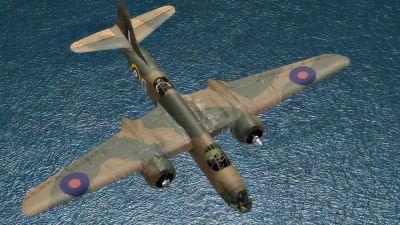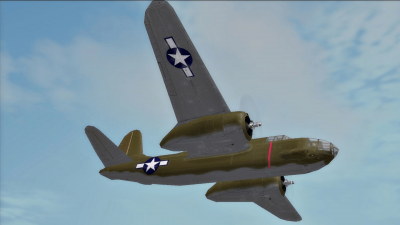Havoc
Boston Mk. I
History
The Douglas DB-7/A-20 Boston/Havoc was one of the most popular and effective light bombers of the Second World War. A total of 7478 were built, serving with the French Armee de l'Air under the designation DB-7, with the USAAF under the designation A-20, and with the RAF, RAAF, and SAAF under the designation Boston and Havoc depending on the variant. The Soviet Union was the largest single user of the Boston/Havoc with over 3000 ending up in service with the Red Air Force (VVS). The Havoc had good performance and excellent handling characteristics.
The Havoc in RAF service originated from a redirected French order, cut short by the surrender in 1940. Originally intended as a short-range tactical attack aircraft by the French, the recently acquired aircraft had too short a range for the RAF to be able to use them as light bombers against German targets in Europe, a problem that was subsequently remedied with the improved Havoc II. For this reason, and because of the need for an airframe capable of carrying a cumbersome airborne radar, the former French machines were converted to act as night fighters and night intruders.
The Havoc/A-20 was truly a legendary attack aircraft that contributed greatly to maintaining offensive pressure in every theatre where it served. While the early models, such as presently offered in Battleground Europe, were only armed with four forward- rifle caliber machine guns and one defensive dorsal gunner, later versions would normally carry six .50 caliber heavy machine guns or four 20mm cannons and two .50 HMG. and include a twin-barreled dorsal turret in place of the single dorsal machine gun. British Havoc I’s were employed with good success against airfields and pin-point strategic targets in Occupied Europe, and the later Havoc III fought with distinction during the famous Channel Dash, and in North Africa. Further orders were sidetracked to Russia from June 1941 onwards, but deliveries of fresh bombers resumed by the end of 1942 and the type saw action until the end of hostilities.
Game Play
The Havoc comes loaded with eight 250 lb General Purpose bombs, four forward-firing machineguns and a single dorsal gunner. Though not quite as devastating as the bombs carried by the DB-7, the Havoc payload is nevertheless sufficient to deal considerable damage to German factories and is especially well suited for battlefield demands. One or two bombs is enough to wreck all but the heaviest German tanks, and any unarmored target is easily dismantled.
Like its sister the DB-7, the Havoc is a potent air-to-air platform as well as a hard-hitting attack aircraft. Once the bomb-bay is empty the Havoc can act as a heavy fighter against enemy bomb carriers, and can spring nasty surprises on single-seat fighters who do not treat the Havoc with proper respect: given half a chance, this is one bomber that can fight back. If you are forced into a turning fight with the Havoc, make heavy use of elevator trim; reverse in 45 degree nose-high attitudes; employ flaps momentarily to increase lift and generally strive to fight the enemy in opposite circles (i.e. work to set up nose-to-nose encounters).
When combating single enemy aircraft, the Havoc formation need not sit idly by and wait for punishment: go into a gentle dive to neutralize the bandit's closure rate and use separation and your forward-firing guns to set up classic 'drag-and-bag' situations.
It is as a level bomber and fast attack aircraft that the Havoc is best suited however. Flying in formation with fighter escort is a grand experience and one that the Havoc does exceptionally well due to its good rate of speed. For attack purposes or when operated in the CAS role, the Havoc can be brought to bear by simple glide bombing practice (see Guides below) or by low-level Rhubarb tactics where bombs are thrown in level flight without using the bombsight.
It is perhaps auspicious to note that the DB-7/Havoc is equipped with hydraulically operated bomb bay doors, requiring the bombardier to open and close said doors by a separate keyboard command (D) at the appropriate time.
A20C Havoc
History
The Douglas A-20C variant was introduced on the production line during early 1941. It was an attempt to standardize on a common British and American version. Based on combat reports from the field, self-sealing fuel tanks and additional armour were added. Now powered by two Wright R-2600-23 Double Cyclone air-cooled radial engines, each rated at 1600 hp for takeoff and 1275 hp at 11,500 feet, the C version was heavier, faster and better armed than its predecessors. Although the Boston/Havoc had been in RAF service for some time, it took a long time before USAAF A-20 crews could become operational in the European theatre. In Europe, USAAF A-20 crews actually flew their first combat missions while attached to RAF units. The first sizable commitment of A-20s under American control did not take place until after Operation Torch, the Allied invasion of North Africa in November of 1942.
While the campaign in North Africa was still underway, plans were made to build up a tactical air forte in support of the upcoming invasion of Europe. Three A-20 Bombardment Groups, the 409th, 410th, and 416th were assigned to the 9th Air Force.
Game Play
In WWII Online, the A-20C is a fast, nimble and capable platform for any attack mission be it at low, medium or high altitude. It's six forward-firing .30 guns rip right through any soft target out there including lightly armored vehicles, and the standard loadout of eight General Purpose 250 lb bombs delivers a strong wallop to any target. As always, you will want to operate this aircraft under conditions of friendly air superiority and, ideally, as a team.
t is as a level bomber and fast attack aircraft that the Havoc is best suited however. Flying in formation with fighter escort is a grand experience and one that the Havoc does exceptionally well due to its good rate of speed. For attack purposes or when operated in the CAS role, the Havoc can be brought to bear by simple glide bombing practice (see Guides below) or by low-level Rhubarb tactics where bombs are thrown in level flight without using the bombsight.
It is perhaps auspicious to note that the DB-7/Havoc is equipped with hydraulically operated bomb bay doors, requiring the bombardier to open and close said doors by a separate keyboard command (D) at the appropriate time
Guides
Level Bombing, Practice and Settings
Low altitude attack, not using bombsight
| Air Units in Battleground Europe | |
|---|---|
| Fighters and fighter bombers | |
| Bf 109E-1 | Bf 109E-4| Bf 109E-4B |Bf 109F-2 | Bf 109F-4 | Bf 109G-2/R1| Bf 109G-6/U4 | Bf 110C-4 | Bf 110C-4/B | Blenheim IF | Dewoitine D.520 | Fw 190A-3B | Fw 190A-4 | Hawk 75 | Hawk 81 | Hawk 87 | P-40F Kittyhawk Fighter Bomber | | Hurricane Mk I | Hurricane Mk IIb | Hurricane Mk IIc | Hurricane Mk IID | Junkers 87G2 'Stuka' | P-38 'Lightning' | Bell Model 14a / P-400 Airacobra | Model 26 / P-39N Airacobra | Spitfire Mk Ia | Spitfire Mk IIb | Spitfire Mk Vb | Spitfire Mk IXc | |
| Bombers | |
| Blenheim IV | Douglas DB-7 | Havoc Mk.I | A20C Havoc | Heinkel 111 | Junkers Ju 88A4 | Junkers 87 'Stuka' | | |
| Transport | |
| C47 'Skytrain' | Junkers 52 | |

